

CarExpert.com.au
The CarExpert team's favourite cars of 2025
4 Days Ago
Kia says its latest electric car in Australia is its most important yet, and it's the brand's best shot at the local sales leaders so far.



Quickly see how this car stacks up against its competition. Select any benchmark to see more details.
Where expert car reviews meet expert car buying – CarExpert gives you trusted advice, personalised service and real savings on your next new car.
Kia has rolled out its most important electric vehicle (EV) yet.

Enter the Kia EV5 – a mid-sized SUV that arrives as the latest and likely most popular member of the Korean brand’s EV lineup in Australia.
While the EV9 seven-seater serves larger families and the more expensive EV6 has sportier leanings, the EV5 is launching as Kia Australia’s most well-rounded electric SUV to date, and it will enter the nation’s single biggest new-vehicle sales segment.
That means it’s being thrown in the deep end against some of the local EV heavy-hitters. Though there are a handful of similar models from other legacy manufacturers, the EV5 has its sights set on the current electric SUV best-seller: the Tesla Model Y.
And it’s off to a flying start. Even despite the numerous price cuts Tesla has rolled out this year, Kia has still managed to undercut the Model Y with its range-opening EV5 Air.

It also presents much more like a traditional car. Where rivals have removed buttons and buried some more important vehicle information behind on-screen menus, Kia has retained a handful of physical controls and given other systems their own easily accessible displays.
As with its other models, Kia says the EV5 has also been subjected to an “an extensive local ride and handling program to ensure it is suitable for Australia’s unique road conditions”.
But to overtake the Model Y in terms of popularity, Kia would likely have to shift upwards of 15,000 examples of the EV5 by this time next year. Tesla has sold 16,697 Model Ys in Australia to the end of September this year, making up a significant portion of the 70,094 EVs sold here in the same period.
For context, Kia’s current best-selling EV is the EV6, which attracted 1470 sales in the first nine months of 2024.

Kia has ambitious plans for the EV5, but EV sales growth has cooled compared to the levels seen in previous years.
While there has been a 6.6 per cent increase in EV sales compared to the first nine months of 2023, hybrid vehicle sales year-to-date are up 87.0 per cent and sales of plug-in hybrids (PHEVs) are up 120.5 per cent.
Despite that, Kia thinks its EV5 still has the potential to earn a spot at the top of the Australian sales charts.
We had the chance to test the EV5’s Air and Earth variants in Sydney earlier this month across a variety of roads and conditions. Does it have what it takes to challenge the Model Y, or will it blend into the background?
With drive-away pricing as cheap as $56,770, Kia has managed to launch the EV5 at a lower price point than the range-opening Model Y RWD ($55,900 before on-roads).

The trend continues at the top of the range, where the incoming GT-Line flagship – arriving later this year – will be cheaper than the Model Y Performance ($82,900 before on-road costs).
It also undercuts Kia’s own smaller Niro EV, which ranges in price from $66,590 to $72,360 before on-road costs.
| Model | Price before on-roads | Drive-away pricing |
|---|---|---|
| 2025 Kia EV5 Air 2WD Standard Range | $56,770 | $56,770 |
| 2025 Kia EV5 Air 2WD Long Range | $61,170 | $63,990 |
| 2025 Kia EV5 Earth AWD Long Range | $64,770 | $68,990 |
| 2025 Kia EV5 GT-Line AWD Long Range | $71,770 | $75,990 |
To see how the Kia EV5 stacks up against its rivals, use our comparison tool.
Buy your new car without the stress. It's fast, simple and completely free.

Great service from Travis and team, second time I have used this business would not hesitate to recommend them to anyone
Craig C.
Purchased a Ford Ranger in Sunshine Coast, QLD
CarExpert helped Craig save thousands on his Ford Ranger, now let us save you on your next new car.
Find a dealIf you’re familiar with the EV9, the EV5 will feel very familiar. If not, there’s no reason you shouldn’t feel right at home.

Unlike some of its more adventurous rivals, the EV5 presents much more like a traditional car. You still have a selection of physical controls in places like the steering wheel and below the central air vents, which are all clearly labelled and easy to locate.
The key departure here is the use of what Kia calls ‘touch-type’ buttons below the infotainment display, which serve as shortcuts for the various menus. They all work reliably and function with a subtle beep when ‘pressed’.
The headlining feature of the EV5’s interior is the colossal three-section display, which incorporates 12.3-inch infotainment and instrument displays on either side of a 5.0-inch climate monitor.
That climate monitor is one of the more thoughtful features here. While Kia has maintained a largely screen-focused design, a dedicated climate monitor allows the driver a greater level of control, meaning you don’t have to dive through the infotainment interface instead.
It’s still a touchscreen display, but it works in conjunction with the central physical switches to control fan speed and temperature. Having this setup is refreshing, and we prefer it to current new-vehicle trends.


The infotainment screen to the left is a solid unit too. It worked flawlessly throughout the hours of driving we undertook, which includes the wireless Apple CarPlay included as standard across the range.
Better yet, that CarPlay interface takes up the entirety of the infotainment display. The various CarPlay apps will also appear on the native system’s home screen, making it easier to operate in the background if you’re outside of your phone’s interface.
Do some digging and you’ll find there’s plenty of information hidden away in here. You’ll be able to do things like adjust many of the vehicle’s settings and view its battery and drive status, and its clean and high-resolution graphics are pleasant to look at.
The instrument cluster is also capable of presenting loads of information, which can be cycled through using the dial on the left of the steering wheel.
As is the theme with the rest of the car, anything you’d want to be looking at on the move is easily found after a few minutes of poking and prodding before you set off.
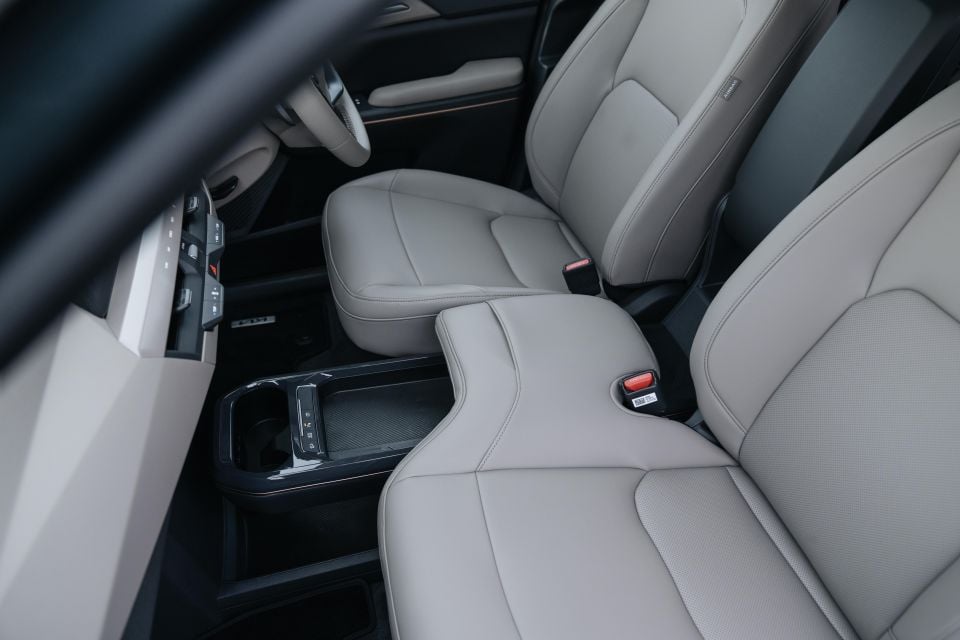
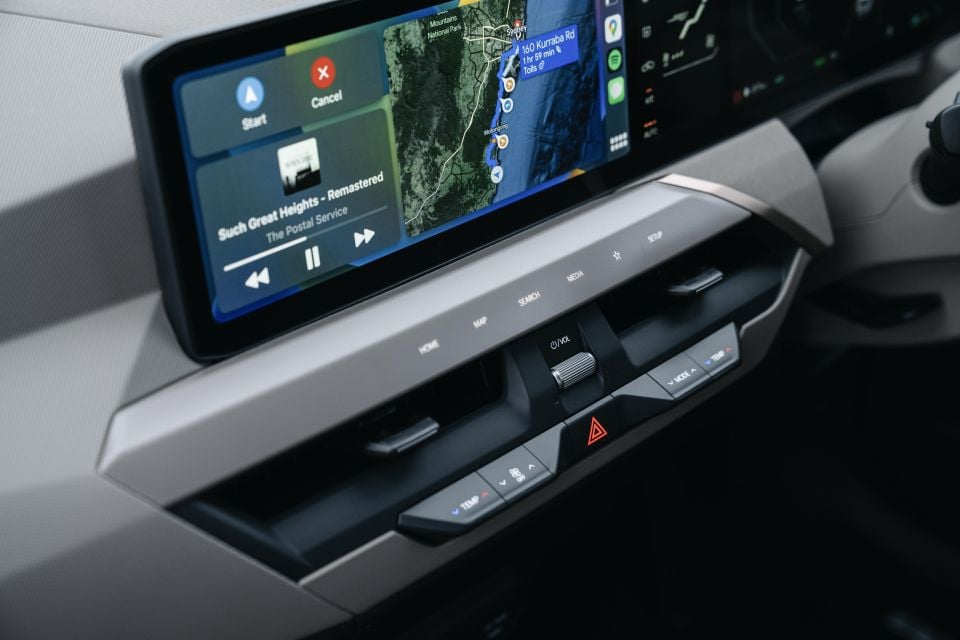
A benefit of the EV5 model range is that the interior stays largely unchanged regardless of the specific variant you’re driving. There are some typical differences like cloth and synthetic leather seat trim in the base Air, versus the fully synthetic upholstery of the Earth, but there’s not a lot you miss out on by going for one of the cheaper options.
The base Air even gets powered driver’s seat adjustment and heated front seats, which are upgraded to include a massage function and power-adjustable passenger seat in the GT-Line.
At such a sharp price point, it’s impressive that Kia has maintained a respectable level of value, and you won’t be underwhelmed if you go straight from the Earth to the Air.
You’d even be forgiven for saying the Air offers a nicer interior than the Earth, because those cloth seats may be nicer to sit in than the synthetic leather alternative. Some may disagree, but there’s no arguing how comfortable the EV5 can be.
Then there’s the design and build quality of the EV5, which is rock-solid all round. The interior design is cohesive and interesting as well, as it’s primarily adorned with hard edges and straight lines.

Nowhere is that more obvious than on the dashboard, which is finished in soft-touch material despite its utilitarian appearance. More of those angular themes appear below the infotainment display, where the air vents and physical climate controls feature sharp edges and straight lines.
There’s almost a rugged, earthen quality to the interior’s design – a fitting theme for the EV5’s Earth variant in particular.
Breaking it up are some subtle metallic elements, namely the angled pieces fitted to the dash, which are finished in a bronze colour. It’s a nice touch, and one that remains consistent regardless of the interior colour chosen.
You have the option of either black or tan interiors in the Earth, and both are equally classy.
In terms of ergonomics, Kia has done well to offer an appropriate range of adjustability while avoiding compromises. The powered driver’s seat that comes standard across the range is part of the reason for this, but there’s also a good range of manual adjustment for the steering wheel.

That wheel appears to have been squashed at the top and bottom, and it’s a quality unit that feels nice in the hand. It appears to us like a progression of similarly styled steering wheels found in cars like the Hyundai Palisade.
Behind it you’ll find traditional stalks for the lights and wipers, as well as the column-style gear selector on the right. You’ll also notice paddle shifters for regenerative braking control, but that’s about it.
Everything here is as you’d expect – it doesn’t feel like Kia is trying to make the EV5 something it isn’t, and it’s better for it.
Kia has created a unique character for its electric SUVs and that means buyers get something different. If that’s what you’re after, there’s no complaints here.
The EV5 offers some quirks too. One you may have noticed is the front seating arrangement, because under the floating armrest appears to be a third front-row seat in the middle.

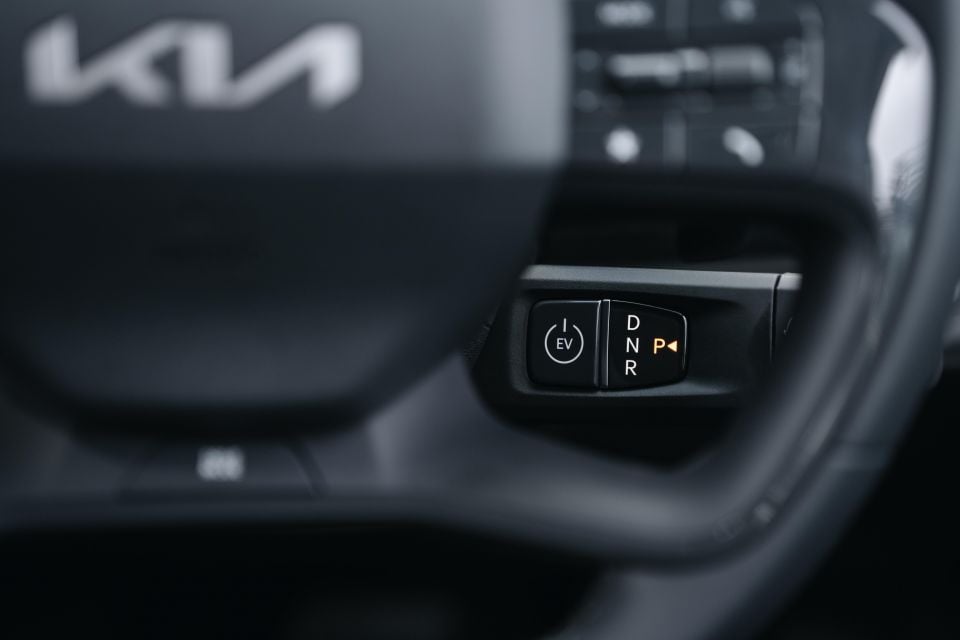
It isn’t actually a seat though; instead it’s an extension of the passenger seat. It doesn’t seem to have any real purpose beyond the small storage pouch on top, so it takes away from potential storage space atop the centre console.
The only benefit is that it may make the front passenger seat appear larger, but the improvement is negligible. We feel the space would have been better utilised by fitting a larger centre console instead.
That said, the centre console you do get in the EV5 is still large. It’s another one of Hyundai/Kia’s ‘floating’ setups, which means you get two large trays for storing large items.
While the tray below is adequately sized, the upper tray – where the GT-Line’s wireless charger is fitted – is compromised by the seat extension. Removing that and extending the tray towards the rear of the car would unlock extra storage space.
At the front of the centre console are a selection of safety-related buttons, as well as two cupholders with a folding central divider.
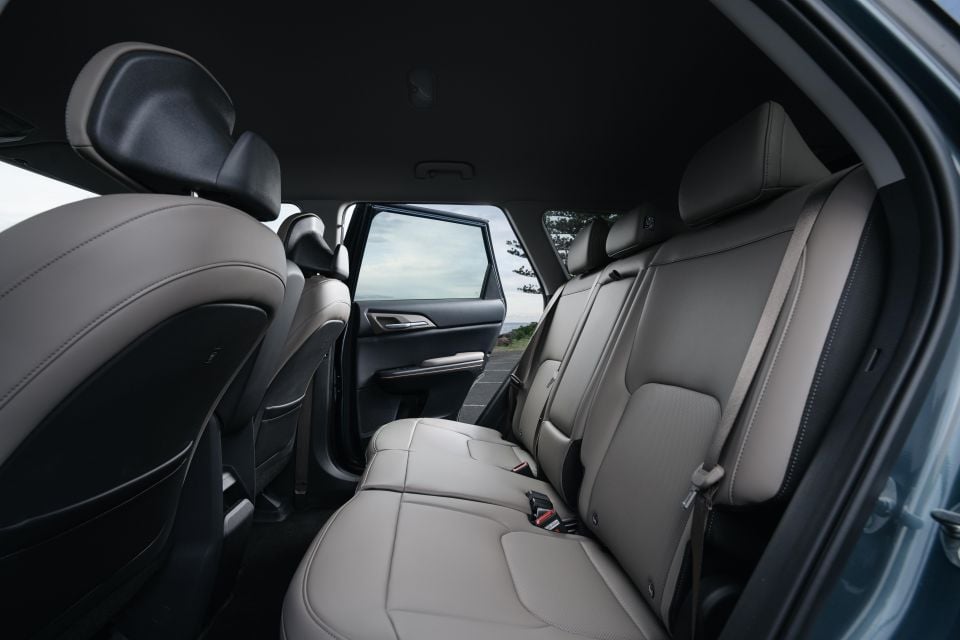
Bottle holders can also be found on the door cards, but beyond the passenger-side glovebox there isn’t much else going on in terms of storage.
If you have small bags you have the option of using a discreet hook at the bottom of the dashboard. A positive is that while storage options seem limited on paper, it doesn’t feel limited once you’re inside.
That means clutter around the cabin is minimal, and there’s still enough space to store loose items like phones, wallets, and keys if need be.
Options for connectivity are kept to a minimum too, with USB-C ports and a 12V outlet located on a panel up front. One USB port is dedicated to phone connectivity, while the other can be toggled between connectivity and charging.
Moving to the rear seats reveals loads of space. In fact, it’s impressive how much room passengers have in the back of the EV5, which is largely a result of the high roofline and neat interior packaging.


Even taller passengers are unlikely to run into issues with headroom or legroom, which gives you plenty of versatility.
Amenities back here are limited, though all EV5 variants benefit from rear air vents and USB-C charging ports located on the front seatbacks.
There’s a fold-down centre armrest with two cupholders too, and it’s generally a comfortable space that would easily accommodate multiple passengers on longer drives.
Passengers in the rear will be able to make use of the sliding storage tray, which resides behind the centre console under the front middle ‘seat’.
In Air and Earth variants it’s a simple sliding tray that can fit drink cans, but in the GT-Line it’ll have heating and cooling functionality added. It’s an interesting feature, but not one that’s going to make or break the EV5.
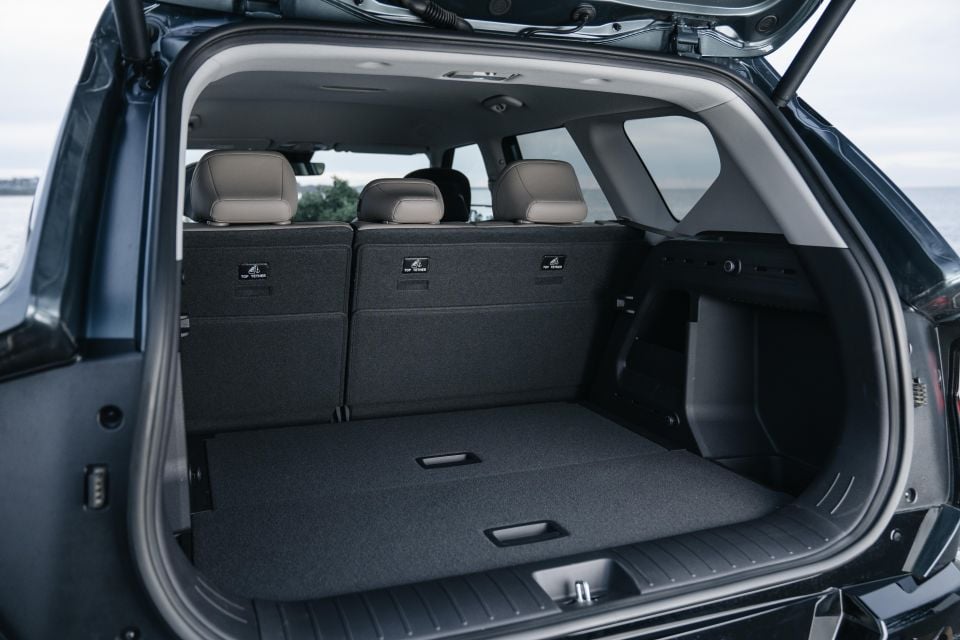

Where expert car reviews meet expert car buying – CarExpert gives you trusted advice, personalised service and real savings on your next new car.
The thought crossed our minds that the installation of that sliding tray required the passenger seat extension to be fitted above, which is already a quirky addition as is.
If that’s the case, we’d much rather go for additional storage up front over a drinks compartment for the rear.
Boot space in the EV5 is excellent. There’s a large, flat load floor to make use of, with a small rounded lip to overcome when sliding cargo in and out.
The floor also splits into two panels that reveal some additional storage space underneath, which can be used for the various charging-related accessories available for the car.
There are small cutouts on either side for loose items, and above you’ll notice another one of the EV5’s unique storage quirks. On either side of the boot are movable pegs, which can be used for hanging small bags and other cargo.

Kia has fitted six mounting locations for these pegs on either side for greater versatility. On the passenger side is a 250V outlet as well, adding to the flexibility of the boot space.
It’s a neat package inside the EV5, and it does well to maintain an appearance that isn’t intimidating for someone wanting to make the jump to an EV.
| Dimensions | Kia EV5 |
|---|---|
| Length | 4615mm |
| Width | 1875mm |
| Height | 1715mm |
| Wheelbase | 2750mm |
| Cargo capacity – VDA | 513 litres – rear seats up 1714 litres – rear seats down 67 litres – frunk |
To see how the Kia EV5 stacks up against its rivals, use our comparison tool.
The Kia EV5 is currently available with three powertrains in both standard and long-range configurations.

A front-wheel drive setup is found in Air variants exclusively, while the others make use of all-wheel drive.
The long-range Air is claimed to be the most efficient variant of the EV5 range, capable of a driving range as long as 555km and energy consumption of 18.0kWh/100km.
On our drive route in and around Sydney, we saw consumption figures between 18.0kWh/100km and 20.0kWh/100km in the Earth AWD, and figures closer to 17.0kWh/100km in the standard range Air – both of which are better than Kia’s claim.
And to be pedantic, under the bonnet is where you’ll find the 67-litre frunk.
| Specifications | Kia EV5 2WD Standard Range | Kia EV5 2WD Long Range | Kia EV5 AWD Long Range |
|---|---|---|---|
| Drivetrain | Single-motor electric | Single-motor electric | Dual-motor electric |
| Batterycapacity | 64.2kWh | 88.1kWh | 88.1kWh |
| Battery chemistry | Lithium iron phosphate | Lithium iron phosphate | Lithium iron phosphate |
| Voltage | 396.8V | 399.4V | 399.4V |
| Power | 160kW | 160kW | 230kW |
| Torque | 310Nm | 310Nm | 480Nm |
| Driven wheels | Front | Front | All-wheel drive |
| Weight – tare | 1910kg 428kg – battery | 2054-2198kg 573kg – battery | 2229kg 574kg – battery |
| 0-100km/h – claimed) | ~8.5 seconds | ~8.9 seconds | ~6.1-6.3 seconds |
| Power consumption – claimed | 18.2kWh/100km | 18.0kWh/100km | 20.1-21.0kWh/100km |
| Claimed range | 400km | 555km | 470-500km |
| Max AC charge rate | 6.6kW | 11kW | 11kW |
| AC charge 10-80 per cent | 9h 43m – 7kW | 8h 10m – 11kW | 8h 10m – 11kW |
| DC charge 10-80 per cent | 57m – 50kW 36m – 350kW | 72m – 50kW 38m – 350kW | 72m – 50kW 38m – 350kW |
To see how the Kia EV5 stacks up against its rivals, use our comparison tool.
There was a high level of expectation for the EV5 ahead of its launch, and for the most part it has been met.

The Korean brand is proudly advertising the fact the car’s development program included extensive testing in Australia, allowing it to be tuned to better tackle the unique conditions our roads offer.
For the most part, it seems to have done the trick. The EV5 is able to handle rough roads easily, and while you’ll definitely still feel the bumps from inside the cabin, it’s by no means enough to make driving an uncomfortable experience.
It’s surprisingly capable of holding its own around corners too, allowing you to carry speed and drive with confidence.
Given it’s a relatively heavy SUV with a sizeable battery pack underneath, it’s impressive how Kia has been able to avoid making it feel like something much larger and more cumbersome.
For that reason, it’s an easy car to drive. The Earth variant in particular is difficult to argue with, given its all-wheel drive setup and power boost over the Air.

With plenty of range and a comfortable ride, the EV5 seems like a great proposition. But while you could certainly do a lot worse, there are some things to keep in mind with the way it behaves.
One has to do with the lane-keep assist function. On the freeway, it behaves excellently and does a good job of holding the car in its lane around bends.
When you don’t have the system activated, warnings rarely flare up while highway driving as the car is happy to leave you to your own devices.
On tighter country roads, however, the system can become obnoxious. Even without the dedicated lane-keeping function active, the passive system is overreactive to bends and changes in the road.
It’ll often try to steer itself back towards the middle of the lane, regardless of whether it’s already there. On turns it’ll steer too early, and on turn exits it’ll keep steering for too long.

If the system was active like it would be if cruise control was engaged, that behaviour would be fine. However, given it happens when you don’t want the system to be on, it can feel like it’s constantly getting in the way.
It’s possible to turn it off entirely through the vehicle settings menu, which can be accessed quickly by pressing the star button on the steering wheel.
In the same menu you can turn of the speed limit warning, which is something you’ll likely want to do given how sensitive it is.
Such a complaint isn’t anything new for Hyundai Group products, but it’s still worth mentioning that you can turn the system off – but it has to be done every time the car is started.
The system would be bearable if the car’s speedometer was completely accurate. It seems as if when matching the speed of traffic around you, the speedo will always read at least 5km/h over the limit and the warning will sound.

Those safety quirks aside, the EV5 is a pleasant car to drive. Road and wind noise are well supressed, and the latter is particularly impressive given the car’s boxy dimensions.
The steering feel is light and direct and changes depending on the drive mode. Press the button at the bottom of the wheel to switch to Sport or Eco modes, and you’ll notice the steering feel changes depending on what is selected.
We noticed the most significant change when in Sport mode, as the steering becomes noticeably heavier. Sport mode also adjusts throttle response, which becomes more aggressive.
Combine both these settings with the AWD setup offered in the Earth and you get a surprisingly capable car.
While it shines as a comfortable, long-drive cruiser on the highway, adjusting the drive settings gives you a nimble and spritely machine on twisty roads.

The same settings are available to you in the Air as well, though that variant has noticeably less power than its AWD counterpart. If you just need an electric SUV as a runaround, the EV5 Air is a top candidate as a result.
Eco mode is available across the range, which prioritises regenerative braking while dulling the amount of power available to save energy.
You can also take control of the regenerative braking system’s intensity using the paddles behind the wheel, which works well for the most part.
Being able to slow down without touching the brake pedal makes for easy driving, and the i-Pedal function is consistent in bringing the car to a complete stop.
We did notice considerable improvements to the car’s economy figures when doing so, but driving in Normal mode gives you plenty of power while still remaining efficient.

Using the regenerative braking for longer periods of time did reveal some issues though.
On long downhill sections, we’d often be using the regenerative braking and hill descent control to keep the car’s speed in check.
While it’s a confidence-inspiring function that allows you to focus solely on steering and the road ahead, we did begin to notice the smell of something getting hot when engaged for long periods of time.
The smell quickly went away when we went back to traditional braking, so it may be best to juggle between both methods when maintaining speeds downhill.
Otherwise, it’s hard to argue with the overall package offered by the EV5. You get comfortable driving dynamics and impressive economy figures, and it can easily be driven like any other car, even if it is an EV.

It would be better if some of the safety system quirks were ironed out. But while some – like the lane-keep assist – can be fairly intrusive, they’re certainly not dangerous.
They can be easily turned off too, with just one button press to take you to their dedicated menu on the touchscreen. It may be annoying to have to do that every time you hop in, but it could quickly become another step in the routine of starting up your car.
Tesla may eke out slightly more range from its equivalent Model Y variants, but jumping from an older car to an EV5 will likely be easier to digest.
To see how the Kia EV5 stacks up against its rivals, use our comparison tool.
Only the Air and Earth EV5 variants are currently available for delivery, with the GT-Line to follow later this year.




EV5 Air highlights:


EV5 Earth adds:
EV5 GT-Line adds:
The Kia EV5 hasn’t been tested by ANCAP or Euro NCAP yet and is therefore unrated.

Standard safety kit includes:
EV5 GT-Line adds:
Kia backs its EV5 with a seven-year, unlimited-kilometre warranty, with servicing required every 12 months or 15,000km – whichever comes first.

The EV5’s battery pack and components are also covered by a seven-year, 150,000km warranty.
Alongside regular service intervals, Kia has outlined pricing for three pre-paid service plans available for either the first three, five or seven years.
| Running costs | Kia EV5 |
|---|---|
| Warranty | 7 years, unlimited kilometres – vehicle 7 years or 150,000 kilometres – EV battery, components |
| Roadside assistance | Up to 8 years – service initiated |
| Service intervals | 12 months or 15,000 kilometres |
| Capped-price servicing | Pre-paid service plans |
| Service plan cost | $980 – 3 years $1535 – 5 years $2431 – 7 years |
To see how the Kia EV5 stacks up against its rivals, use our comparison tool.
Kia expects the EV5 will be its best-selling EV to date, and it’s easy to see why.

It’s a much better-rounded package than both the EV6 and EV9, while also coming in cheaper than the similar Niro EV.
If you’re coming from an older car, it offers a much less intimidating setup than its rivals. The interior of the EV5 may be modern, but it isn’t quite at the ‘spaceship’ level that can be a dealbreaker for many EV buyers.
While there are some nice additions as you travel further up the model range, the base EV5 variants hardly miss out on any of the things that make the car so appealing. Better yet, there’s enough variety in the range to allow customers to buy the specific EV5 that will best suit their individual needs.
All of that, and it’s still cheaper than an equivalent Model Y.

There are some quirks that need to be ironed out. The passive lane-keep assist is too active, which can be unnerving on narrow or windy roads.
Systems relating to the car’s speed could also do with finer calibration, as it’s annoying to be warned for speeding when you aren’t actually exceeding the speed limit.
But overall, the EV5 is a case of what you see is what you get. Kia’s answer to a market segment that is currently dominated by just one player isn’t trying to mimic something else and has its own unique flavour.
If you’re someone wanting to switch to a mid-sized electric SUV but don’t want a Tesla, the EV5 – in any of its variants – may well be the answer.

Interested in buying a Kia EV5? Get in touch with one of CarExpert’s trusted dealers here
Click the images for the full gallery
MORE: Everything Kia EV5
Where expert car reviews meet expert car buying – CarExpert gives you trusted advice, personalised service and real savings on your next new car.
Max Davies is a CarExpert journalist with a background in regional media, with a passion for Japanese brands and motorsport.


CarExpert.com.au
4 Days Ago


Damion Smy
4 Days Ago


Damion Smy
5 Days Ago


Josh Nevett
5 Days Ago


Max Davies
5 Days Ago


Ben Zachariah
6 Days Ago